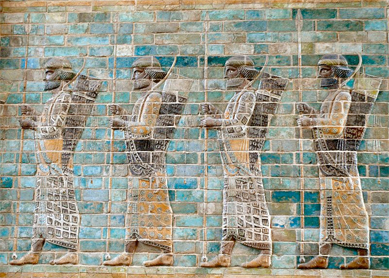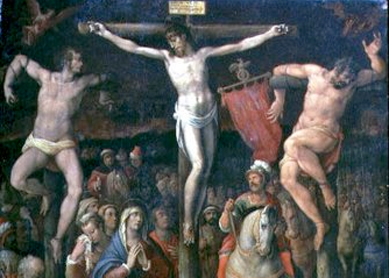Pontius Pilate was the Roman governor of Judea (26-37 CE) during the reign of the Emperor Tiberius (14-37 CE). His claim to fame is his role in crucifying Jesus.
We do not know many details about his life. Apart from the New Testament gospels, two first-century Jewish writers, Philo of Alexandria (Embassy to Gaius 299-305) and Josephus of Rome (Jewish War 2.169-77; Antiquities of the Jews 18.55-89), briefly mention him. An inscription discovered in Caesarea in 1961 and some coins also attest to him.
His appointment as governor, nevertheless, indicates that he came from a wealthy, powerful, elite family that was probably well connected with the emperor Tiberius. Most likely he had previous military and administrative experience. Philo’s and Josephus’s accounts of Pilate’s actions suggest insensitivity to Jewish customs typical of elite Roman prejudices toward provincials.
Pilate: A Weak Wimp …?
Scholars have debated Pilate’s role in Jesus’s crucifixion. Pilate has usually been understood as a weak figure whom the Jerusalem leaders bully into crucifying Jesus. This reading emphasizes that Pilate thinks Jesus is innocent, wondering “what evil has he done?” (Mark 15:14; Matt 27:23; Luke 23:4, Luke 23:14-22). Yet he is weak and cannot stand up to these leaders (Mark 15:11-15; Matt 27:23-27; Luke 23:23-25; John 19:12-16). Threatened by possible crowd violence and by accusations of his disloyalty to the emperor if he does not crucify Jesus (John 19:12), Pilate tamely yields to their demands. This approach constructs Pilate as a weak wimp, powerless and disinterested.
Throughout two millennia, Christian interpreters have diminished Pilate’s role in Jesus’s crucifixion for several reasons. A long Christian tradition has blamed the Jerusalem leaders and crowds for Jesus’s death. In the early centuries of the church, apocryphal stories emerged that removed all responsibility from Pilate and transferred it to the Jerusalem leaders. One story has Jesus giving Pilate permission to crucify him while blaming the Jewish leaders. Another story has the emperor Tiberius and Pilate blame the Jews for Jesus’s execution; Tiberius punishes them with a military attack and scatters them from Judea. Foregrounding the Jerusalem leaders emphasizes their responsibility. Such readings are marked by a strong anti-Judaism tone.
Moreover, Christian interpreters have often read the New Testament passages concerning Pilate with the presupposition that the gospels deal with religious, not political, matters. The governor Pilate is understood to be reluctant to get involved in what Christian interpreters have often depicted as a religious dispute involving Jerusalem’s religious leaders and Jesus, a religious figure. Pilate has to be bullied into action by the Jerusalem leaders as they pursue their religious agenda against Jesus.
… or an Astute and Strong Governor?
This “weak Pilate” approach, however, has unrealistically played down the power and responsibilities entrusted to Roman governors. Governors were the face of Rome’s empire and power in the provinces. Pilate represented Rome’s political and economic interests, defended its hierarchical societal structure, and ensured submission and order in the provinces. As governor, Pilate exercised military, political, social, judicial, and economic power for the benefit of Rome’s ruling elites. Governor Pilate was not a wimp. Pilate’s apparent reluctance to execute Jesus can be understood very differently, then, in the context of Pilate’s power as governor.
His initial refusal of the Jerusalem leaders’ request to crucify Jesus is a ploy, a strategy to assert his dominance. As Judea’s governor, Pilate rules in alliance with the Jerusalem leaders. These leaders were not just religious figures. Josephus identifies them as the native rulers of Judea (Antiquities 20.251). Pilate shared with them the common interest of maintaining the imperial system that secured their wealth, power, and status as ruling elites. Yet tensions and power struggles for ascendancy marked this ruling alliance. Rome stacked the deck. The governor appointed the chief priests and maintained the power to execute challengers to the system.
The Jerusalem leaders saw Jesus, his followers, and interested crowds as a threat. He openly proclaimed the “kingdom” or “empire” of God and was called “king of the Jews” (Mark 15:2; Luke 23:2). This title is treasonous since only Rome could appoint or sanction kings in provinces; they had not sanctioned Jesus. So to protect their position as rulers against a potential threat, they ask Pilate to crucify Jesus.
Since Pilate’s allies are concerned about Jesus, so is Pilate. They share common interests in maintaining the status quo. But he can’t instantly yield to their demand; that would make him their lackey. Rather, he uses their request to subordinate them further. He makes them beg. Several times he says he sees no threat. Each time they beg for Jesus’s crucifixion, submitting themselves further to Pilate’s power. When the crowd joins in begging, Pilate learns that there will not be a riot when he crucifies this kingly wannabe.
Governor Pilate completes an astute piece of governing. He does what they want but only after he has increased his power over them.





